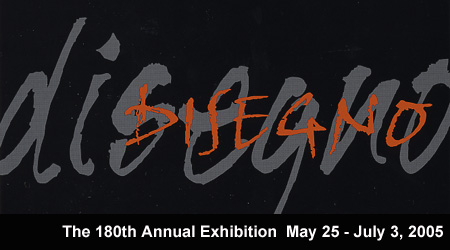Disegno
dal 23/5/2005 al 3/7/2005
Segnalato da
Gregory Amenoff
Robert Cottingham
Elizabeth Catlett
Lois Dodd
Janet Fish
Red Grooms
Joyce Kozloff
Richard Meier
Miriam Schapiro
George Tooker
23/5/2005
Disegno
National Academy Museum, New York
The museum is making a 180 degree turnaround in this year's Annual exhibition. The show has a theme that offers viewers an intimate glimpse into the inner workings of an artist's mind. Focusing on studies - the most immediate, often rough and spontaneous of creations - indeed, an artist's starting point - works include a variety of mediums by Academicians from throughout the country.

The 180th Annual Exhibition
In celebration of the Academy's 180th anniversary, the museum is making a 180 degree turnaround in this year's Annual exhibition. Every other year, Annual exhibitions are reserved for artist members (Academicians) only and these shows have generally been known for their works of high finish. This year however, the exhibition has a theme, and one that offers viewers an intimate glimpse into the inner workings of an artist's mind. Focusing on studies - the most immediate, often rough and spontaneous of creations - indeed, an artist's starting point - works include a variety of mediums by Academicians from throughout the country including Gregory Amenoff, Robert Cottingham, Elizabeth Catlett, Lois Dodd, Janet Fish, Red Grooms, Joyce Kozloff, Richard Meier, Miriam Schapiro and George Tooker among others.
For the artists in Disegno, "studies" has a multitude of meanings. To many artists, it represents the very genesis of their creative process. Before approaching a work, endless sketches, maquettes, or other preparatory pieces are made, refined, and re-worked until the artist feels that he or she is ready to put brush to canvas, chisel to stone - to make a mark of permanence. For other artists, studies are not part of the process at all, and in fact, are viewed as unnecessary and limiting. As regards this show, these particular artists are exhibiting "studies" in the sense that they are either the first in a series of works, or a smaller piece - a print or watercolor for example - for what later becomes a larger work - a sizeable oil, for instance.
Michelle Stuart's mixed media work is a study for a yet unrealized set design for The Dance of the Earth ballet (Part I of Stravinsky's The Rite of Spring). In keeping with the theme of the dance and Stravinsky's composition, Stuart incorporates environmental elements such as seeds, hemp and dirt into her piece. The whirly, curvilinear lines of the work suggest motion, mimicking the moves of the dancers. The sparse, somewhat "discordant" composition perfectly complements Stravinsky's own atonal approach.
Robert Cottingham's Roxy lithograph is representative of the renowned photorealist painter's interest in Americana - i.e. old signage, antiquated cameras, typewriters and other ephemera. As part of his working process, he often creates prints and paintings simultaneously, stating, "While my work as a painter visually informs my prints, the printmaking process, with its spirit of collaboration and experimentation, invariably influence my paintings."
Joyce Kozloff is represented by a colored pencil on paper abstraction created for a marble mosaic floor installation for the Chubu Cultural Center in Kurayosh, Japan. Here the intricate designs are reminiscent of works from the pattern and decoration movement of the 1970's that Kozloff pioneered along with Miriam Shapiro.
Antonio Frasconi's color woodcut, Mission Accomplished is an indictment against the Bush administration. This study addresses the event of May 1, 2003 in which the President gallantly flew aboard the battleship, USS Abraham Lincoln, and prematurely declared "Mission Accomplished" with regard to United Sates agenda in the war in Iraq. Here, featured in flight attire, the commander in chief signals a thumb's up, yet he stands high atop a pile of dead soldiers. Mission Accomplished, written at the bottom of the work, is a nod to the banner that was on the battleship that day, and furthers this juxtaposition. Even in this preliminary, intimate scale, Frasconi works not only on the logistics of color and composition, but on perfecting his political message to viewers as well.
Pat Lasch's sculpture, Anna Reclining with Eggs, constitutes a study because it is one section of a group of figures with an evolving narrative story. The viewer approaches this sculpture almost as a voyeur, interrupting the figure in an uncertain state of repose. We are unsure as to what we are witnessing and the coarseness of the artist's materials adds to the psychological effect it produces. Is this a woman in agony or sleeping? And what do the eggs represent? Fertility? Extracted from the others in the series, the viewer is given no answers, and this becomes simply a frozen moment, the work an isolated scene from the narrative.
Studies are rare gems in that they often delineate the specific ways in which an artist plans a project and how he or she arrives at its realization. Disegno: The 180th Annual Exhibition provides viewers an opportunity to follow the initial creative process, a sort of behind the scenes tour into the minds of many of the country's most prominent artists working in a variety of mediums.
The catalogue which will accompany this exhibition features not only reproductions of each artist's work, but will also include a reproduction of the finished work, if realized, for which each study was made.
Awards Ceremony: May 24 6:30 P.m.
National Academy Museum
1083 Fifth Avenue
New York, NY 10128



